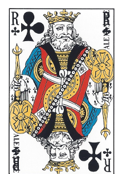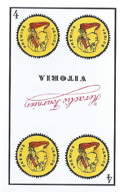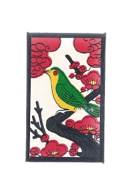Both sides of the modern playing-card - the faces and the backs - are useful for classification. Standard faces are typically a combination of numeric 'pip' cards and courts, while non-standard card faces can - and do - show just about anything. The backs can be plain (as they were for many centuries) or patterned, or they may show a photographic souvenir or advertising or indeed any kind of artistic design. Backs should all be the same of course, but even here there are exceptions like deliberately marked decks.
|
|
English King of Clubs by Llewellyn c. 1780. This is a full length court card, the type in use from the 1500s until around 1900 |
English Queen of Diamonds by Waddington, 1980s. This is a double-ended court card, in use from the 1860's onwards. |
The first time one encounters standard cards from another country, it may come as a surprise. Playing cards were in use in Europe some time before we had them in England and the rest of the UK. Separate suit systems evolved in Spain and Italy (among the earliest cards, and broadly similar in design) and in Germany and France. It is the French style, specifically the Rouen regional pattern, which the English makers adopted. Additionally India and Japan have also created card games with quite different structures. Most other countries use local variants of these European patterns, and cards with indices of course have local lettering in the abbreviations for the equivalent of Jacks, Queens and Kings.
These differences are a key to country identification. A summary is presented below, together with links to good examples of each pattern.
 |
 |
 |
 |
Standard French: King of Clubs, 1980s. |
Standard Spanish cards: 4 of Coins by Fournier, 1990s. |
Italian Cards: Sicilian 4 of Swords by Modiano, 2000s. |
Japanese "Hana Fuda" or flower cards, 1980s. |
Country/ies |
Indices for |
Suits |
Cards |
Pattern Sheets/ Examples |
Spain, South America |
10 11 12 1 |
Swords Cups Coins Clubs/ Batons |
Usually 48 cards |
|
Italy |
Often not used |
Swords Cups Coins Clubs/ Batons |
Usually 40 |
|
France, Belgium, NL, Switzerland, International |
R D V A/1 |
French: piques (spades), coeurs (hearts), carre' (diamonds), batons (Clubs) |
note: court cards are often named (eg 'David' for Roi de Piques, our KS) |
|
Germany/ Germanic |
K O U A |
trad germanic: acorns, hearts, bells, leaves |
|
|
England, |
K Q J A |
French: spades, hearts, diamonds, clubs |
Joker(s) from 1870s |
|
Switzerland |
König Ober Under A/1 |
germanic and french |
|
|
India |
|
|
Round cards, beautifully illustrated |
|
Japan |
|
|
Small but thick square-cornered cards with flowers and birds |
|
Holland |
H V B 1/A |
|
|
Denmark, |
K D B A |
|
|
|
Denmark |
K D B Es |
|
|
|
Iceland |
K D G As |
|
|
|
Sweden |
K D J E |
|
|
|
Finland |
K D K 1 or KRS1 |
|
|
|
Russia |
K ? B T |
|
|
|
Greece |
B K θ A |
|
|
Non-standard cards have re-designed faces, or, like pictorial cards for example, they may not be intended for playing with at all. For these cards, the main division is the type of design on the face. There are some minor differences in terms used for non-standard cards, for example Pictorial or Illustrated: 'illustrated' suggests only the hand-drawn storyboard type of pack, so Pictorial more general.
|
|
|
Non-Standard circular English King of Spades by Waddington, 1980s. |
Artistic 3 of Clubs. The designs are correct when viewed with a cylindrical reflector - supplied! 1980s. |
Pictorial cards further described as geographical. They are also facsimiles from 1970s. |
|
|
|
A transformation pack - The 3 of diamonds from the S & J Fuller 'Metastasis' pack of 1811. |
Pictorial 2 of spades from 'Cries of London', an illustrated pack of 1754. |
Non-standard The Art Deck by Andrew Jones featuring designs from major contemporary artists 1979 |
Nowadays, back designs are an integral part of the playing card and indeed they are often the main interest for many collectors. The first known backs with an original design were made for the Coronation of King William and Queen Adelaide in 1831. Other than plain backs, some earlier cards have simple colours and lines or stencilled geometry. The firm that revolutionised back design was De La Rue, taking full advantage of their new mastery of full colour lithoigraphy. Their richly decorated backs begain in 1844 and carried designs created by Owen Jones (an architect and writer on design).
The basic artistic type is generally intended to showcase the artist or simply to make the cards more attractive to play with. It was not long before card backs were used for promotional purposes too - advertising and marketing with specific sub-categories like films, drinks, cigarettes, airlines, railways, luxury brands and charities.
Two other major types are souvenir and commemorative. Souvenir cards feature a specific place or event whereas commemorative cards relate to a date or anniversary. The annual WCMPC backs are almost all in this commemorative category. This short list of categories captures most of the back types, since sub-categories can be created to reflect the enormous diversity within.
|
|
||
|
|
|
|
Commemorative - Mexico Olympic Games. WCMPC 1968. |
Souvenir Canterbury Cathedral from 1970s. |
Advertising from 1990s |
|
|
|
|
|
Decorative: Owen Jones for De La Rue 1850. |
Fanning deck - details of front and back. Japanese c.1990s. |
Marked deck by Lagoon Games 2000s. |
|
Item |
Possible Entries/ Primary Type |
Categories within Type |
Meanings/comments/ examples |
Catalogue Number |
Assigned by person entering data |
Show collection? (eg WCMPC/ Waddington...) |
Unique code |
Description |
Assigned by person entering data but editable later. From pack if given, can 'invent' if not |
|
eg ‘WCMPC 1973’ eg ‘Disney Theme’ |
Face Type |
Standard |
Country, Region |
e.g. Spanish
|
Face Type |
Tarot |
Tarot |
|
|
Minchiate |
Minchiate |
|
Face Type |
Pictorial |
|
Any set with pictures/ without standard faces. |
|
Pictorial |
Historical |
Spanish Armada |
|
Pictorial |
Educational |
Arithmetical |
|
Pictorial |
Geographical |
Morden’s Maps
|
|
Pictorial |
Political |
Popish Plot |
|
Pictorial |
Satire |
All the bubbles |
|
Pictorial |
Humour |
Willie Rushton's Royals
|
|
Pictorial |
Heraldic |
Arms of English Peers |
|
Pictorial |
Entertainment |
Love Mottoes |
|
Pictorial |
Astrological |
Hodges |
|
Pictorial |
Costumes |
Trades and classes |
|
Pictorial |
Artistic |
The Art Deck
|
|
Pictorial |
Scenic |
US Rail Photography |
|
Pictorial |
Musical |
Beggars Opera |
Face Type |
Transformation
|
Printed/ Hand Drawn (i.e. ink on cards)
|
Standard faces with added artwork |
Face Type |
Others |
New Suit Signs
|
Rowley, 5-suits
<
|
|
Others |
No-Revoke |
Arpak
|
|
Others |
Facsimiles |
Morden Geographical
|
|
Others |
Novelties/Shapes |
Magic, Round |
|
Others |
Other Games |
Mah-jongg, dominoes! |
Item |
Possible Entries/ Primary Type |
Categories within Type |
Meanings/comments/ examples
|
Back Design
|
Promotional
|
Advertising
|
Guiness |
|
Promotional |
Films |
Harry Potter |
|
Promotional |
Airline |
BA |
|
Promotional |
Railway |
Amtrak |
|
Promotional |
Cars |
Austin |
|
Promotional |
Charity |
Lifeboats |
|
Promotional |
Casino |
Caesars Palace |
|
Promotional |
Brand |
Tiffany |
Back Design
|
Commemorative (date) |
Royalty |
Royal Wedding |
Back Design |
Souvenir (place or institution) |
|
|
|
Souvenir |
State/area |
Florida |
|
Souvenir |
City/Town |
Boston |
|
Souvenir |
Museum |
Natural History |
|
Souvenir |
Building |
United Nations |
|
Souvenir |
Attraction |
Disney World |
|
Souvenir |
University |
Oxford |
|
Souvenir |
Livery Co. |
Glassmakers |
|
Souvenir |
Union |
TUC |
|
Souvenir |
Club |
Conservative Club |
|
Souvenir |
Sports |
World Cup |
Back Design |
Artistic |
Named artist |
Owen Jones, Barribal |
Back Design |
Others |
Secondary Use |
foundlings |
|
Others |
Marked Cards |
magic/gambling |
|
Others |
Plain back |
most cards before 1840! |
Country (manufacture) |
|
|
although ‘basic’, this can be difficult to identify. |
|
|
|
|
OTHER I |
|
|
|
Maker |
|
|
|
Date |
|
|
|
Heritage Tag |
To be decided |
|
Made in London London history Educational (now) Represents a tradition Rare/valuable |
Education Tag |
To be decided |
|
Counting Game Local history |
Keywords |
(Searchable terms) |
|
Any |
The Physical Card and Pack
Item |
Entries |
Categories within Type |
Meanings/comments/ examples |
Package |
|
|
Describe package cards came in e.g. 'double in box.', 'includes patience games booklet'... |
Count |
cards present |
|
e.g. 51+2J+2 |
Full Count |
cards in full pack |
|
e.g. 52+2J+2 |
Size |
height mm width mm thickness mm |
|
95mm 65mm 0.8 mm (pack/52) |
Material |
|
|
Card/ Metal/ plastic |
Card Stock |
|
|
3-ply hand made |
Print method |
|
|
Block/ Litho etc. |
Print ink |
|
|
colours, dyes? |
Edging |
|
|
gilded |
Curatorial Entries (examples)
Item |
Entries |
Categories within Type |
Meanings/comments/ examples |
Date acquired |
|
|
1910 |
Donor/Source |
|
|
Master |
Value |
|
|
£150 |
Physical Location |
|
|
LMA Room X Shelf 8 |
Storage format |
|
|
In original box |
In order to survey the accepted state of practice, I have consulted a number of familiar and trusted playing-card sources and catalogues: Sylvia Mann (her own collection), John Berry (WCMPC, Waddington, his own collection), Jean Hamilton (V&A), Willshire (British Museum), Yasha Beresiner (Ortiz Patino), Cary (Yale), Catherine Perry Hargrave (USPCC), Fournier (Museo Fournier), Dawson & Dawson (Hochman Encyclopedia of US cards) and Mike Goodall (Minor Makers series and Goodall reference books).
Fortunately there are far more similarities than differences between the systems used in all these sources. Several (Mann, Hochman, Goodall) use fewer categories simply because they cover playing cards of a specific country, or of a specific type (often standard). Others (Hamilton, Fournier) only categorise by Country and only include further details in the individual descriptions. In choosing categories for use here, self-explanatory choices are strongly favoured so that the scheme can be useful beyond a relatively small number of experts.
Paul Bostock, July 2015.